Getting off the couch, out of the office, or away from the kids and getting into the gym is hard. When the clock strikes midnight on January 1st, millions of Americans think that this is their chance to become the workout warrior of their dreams. This overwhelmingly does not happen.
So, why is it so hard to work out? What can you do to make it easier? And, where do you start?
We can help whether you’re starting as part of your New Year’s resolution to exercise or just want to jumpstart your health.
Why Do You Need to Workout?
Before getting back to the gym, don’t you want to know why you should be working out?
Regular exercise can improve your health in a wide variety of ways, improving:
- Mental Wellness
- Physical Acumen
- Long-Term Health
Mental Wellness
For centuries, we have known that working positively impacts physical health. This makes intuitive sense. However, we’re just now learning of the power exercise can have on the mind. Studies have recently shown that as little as 30 minutes of moderate exercise can increase mood, reduce stress, and counteract depression. Exercise is a great boost to your mindset after a long day of work or any stress-inducing event. Additionally, for individuals suffering from mental health disorders, daily exercise can significantly reduce symptoms.
Physical Acumen
The most obvious outcome of daily exercise is an improvement in physical capabilities. Regular workouts help prevent weight gain. They can also delay the natural effects of aging like arthritis, bone weakness, and muscle deficiency. In short: Working out keeps you younger.
Long Term Health
Regular physical activity is one of the best things you can do to live a long and healthy life. Among other benefits, it can reduce your risk of:
- High blood pressure
- Heart disease
- Diabetes
- Various forms of cancer
A Chronic Illness Epidemic
The Center for Disease Control reports that only half of American adults get the appropriate amount of physical activity necessary to help reduce the risk of chronic diseases. In turn, one of every two American adults suffers from a chronic illness. Of that group, half suffer from multiple chronic illnesses. Working out isn’t just for looking good at the beach; it's for living a long and healthy life.
Staying On Track
Sticking with an exercise routine can be difficult. It doesn’t have to be as daunting as it seems. Starting a new routine is about finding a plan that works for you. Working out needs to be convenient and enjoyable.
Find the time of day that works best for you. That could be in your office while on lunch break, stopping at the gym on the way home, or in the morning before anyone else in the house is awake. Whatever the case may be, you shouldn't feel like working out is taking away from the rest of your day.
You have to have fun with it, too. If you don’t find the fitness plan that you enjoy, your chances of sticking with it are drastically reduced. Try a wide variety of different exercises. Maybe running is for you. Maybe the rush of hitting that final rep on the bench is what you need to get motivated. You could even try classes like cycling or yoga. Having fun is the best way to develop the perfect routine.
How to Start Exercising
Starting a new workout plan may seem daunting. Do I need equipment? What about a gym membership? Do I have to lift weights?
The answer to all of these questions is “no”. You just need the right attitude and some direction. There are three main types of exercises for beginners:
- Aerobics
- Strength Training
- Flexibility Routines
Aerobics for Beginners
Cardio exercises, also known as aerobics, are any activity that requires muscle movement in large, repetitive processes. This includes running, jogging, cycling, swimming, and any organized sport.
The best part about aerobics is that you can do it anytime, anywhere. Everything from walking to the office to mowing the lawn exercises the body in this way. If you don’t have time for a jog today, park on the other end of the parking lot. Give your walk some pace and take the stairs instead of the elevator. Small adjustments like these can give your day a boost of physical activity.
Looking to increase your heart rate? Go for a jog, play a game of pickup basketball, or take out that bike that you never use.
Anything that makes you break a sweat is a good aerobic exercise.
THERABAND Cuff Weight Walk
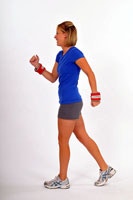
Boost your average jog to the next level by adding some weight with a THERABAND Cuff. This makes even walking a good challenge for beginner fitness enthusiasts. Weights can also be worn on the ankles.
- Tightly secure a cuff to each wrist
- Begin walking
- With each step, be sure to fully flex your elbow
THERABAND Stability Disc Stepping
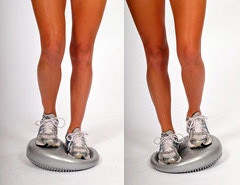
- Place both feet on the THERABAND Stability Disc with an even distance between each foot and the end of the disc
- Step on the disc one foot at a time, pressing one foot down and then the other
- Tip: Keep a sturdy object close to help you balance
Strength Training
Strength training offers other benefits that aerobic exercises do not. Muscular fitness and bone strength are both increased by strength training activities. These exercises make great compliments to aerobic exercises.
Activities that challenge your strength are also common on a daily basis. Lifting heavy boxes and extensive yard work both cause your muscles to exert large amounts of force.
Using free-weights and resistance bands also push your muscles to the limit (Check out Performance Health Academy to learn more about using resistance tools).
THERABAND Shoulder Seated Row
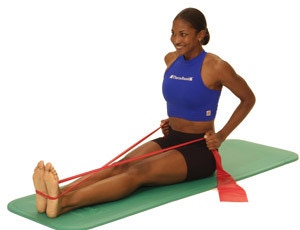
1. Sit on the ground with your legs fully extended and wrap a THERABAND Resistance Band around your feet
- Tip: Wrap the band around the middle of your feet to help keep it in place
2. Extend your arms towards your feet and grip the bands, leaving little slack
3. Pull the bands towards your body by bending your elbows and rotating your shoulders
- Tip: Keep your legs and back straight with your arms always by your sides
If you don’t have any equipment right now, try calisthenics. Calisthenics uses the body’s own weight to exert force on specific muscles. Common calisthenics includes push-ups and planks.
THERABAND Stability Disc Abdominal Crunch
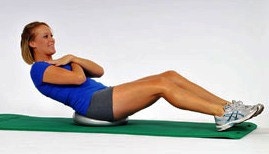
- With a TheraBand Stability Disc under your hips, at the top of the glutes, lay on your back with your knees slightly bent
- Cross your hands over your chest and slowly curly upwards, bending at the abdomen
- Lower yourself back down and repeat
Flexibility Routines
The effects of stretching are a relatively unstudied field of athletics and physiology. However, in the short term, stretching has shown to increase overall flexibility in the joints and muscles.
This increases your range of motion, making it more comfortable and easy to move your body. While the benefits of flexibility exercises remain somewhat of a mystery, this much is true: They help you move better and feel great.
Thera-Band FlexBar Knee Flexion Mobilization
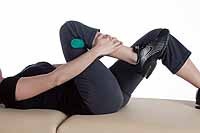
This exercise can be done to stretch out your legs and arms before or after a workout. It can also be performed at the elbow joint instead of the knee to give your arms a more intense stretch.
- Lie on your back with your knees bent and feet resting on the ground
- Place a TheraBand FlexBar under your knee below the joint
- Bring the knee towards your chest, squeezing the bar between the bottom of your thigh and top of your calf
- Tip: Clasp your hands around your shin and pull your lower leg towards your thigh to exercise your arms and increase stretching at the knee
- Once your leg is pulled in to the point where you feel a tight stretching, hold for 15 seconds and then release
Keep Stretching Simple
You don’t need to load up on brand new equipment to get a good stretch in. When working on your personal fitness, staying simple is the best way to start. Here are four exercises you can do with a single TheraBand Stretch Strap.
How Much Exercise Do I Need?
- Research shows that exercising 3 days per week is linked to health benefits
- 150 minutes of moderate-intensity exercise per week has significant benefits including a lowered risk of:
- Stroke
- Heart disease
- Cancer
- Depression
- Type 2 Diabetes
- And more
- Increasing to 300 minutes of exercise per week can be life-changing
- Additional reduced risk of Type 2 Diabetes and heart disease
What Intensity Level Should I Target?
The 150 minute-mark is based on a moderate level of intensity. Swimming, dancing, and yard work are all moderate-intensity exercises. High-intensity exercises (running, hiking, fast cycling, etc.) typically work the body twice as hard as moderate-intensity activities.
A balanced workout routine is important. Just because you can cut your exercise time in half by only performing high-intensity activities doesn’t mean you should. Challenging the body on both difficulty and duration is the best way to get the most out of a workout.
You’ve got all of the tools you need to get into exercising. Go out, get fit, and most importantly, have fun!
References
ODHP. (2018, November 07). 5 Factors That Help People Stick to a New Exercise Habit. Retrieved from https://bit.ly/2WA2ISR
U.S. Department of Health and Human Services. (2018). Physical Activity Guidelines for Americans. Retrieved from https://bit.ly/2GaX6qB
Why It Matters | Physical Activity. (2019, February 4). Retrieved from https://bit.ly/2QAfVVj
Medical Disclaimer: The information provided on this site, including text, graphics, images and other material, are for informational purposes only and are not intended to substitute for professional medical advice, diagnosis or treatment. Always seek the advice of your physician or other healthcare professional with any questions or concerns you may have regarding your condition.








 France
France Australia
Australia


